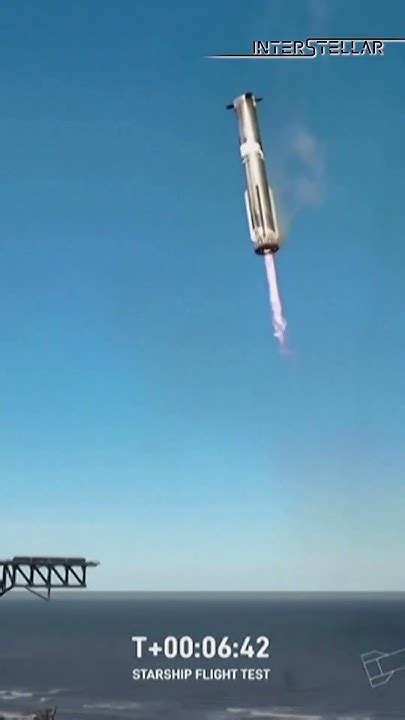
SpaceX’s Starship, the world’s most powerful rocket, experienced a fiery disintegration over the Indian Ocean on Thursday after suffering an anomaly during its fourth integrated test flight. While the launch and initial phases of the flight appeared successful, including a controlled ascent and stage separation, the vehicle failed to execute a planned soft landing.
The uncrewed Starship, consisting of the Super Heavy booster and the Starship upper stage, lifted off from SpaceX’s Starbase facility near Brownsville, Texas, at approximately 8:50 a.m. ET. The launch, streamed live by SpaceX, showed a seemingly flawless ascent, with the Super Heavy booster separating from the Starship upper stage as planned. This test aimed to achieve controlled re-entry and a soft landing in the ocean for both stages, marking significant progress toward the company’s goal of developing a fully reusable transportation system designed for deep space exploration.
However, the mission encountered difficulties during the final descent phase. According to SpaceX, the Starship experienced a rapid unscheduled disassembly, essentially exploding, as it approached the intended splashdown location in the Indian Ocean. The company acknowledged the anomaly but emphasized the valuable data collected throughout the flight. “Starship made it far! Splashdown imminent!,” SpaceX posted on its X account just before the signal was lost, highlighting the anticipation surrounding the landing attempt.
The Super Heavy booster, which was undertaking its own controlled descent back towards the Gulf of Mexico, also encountered issues. Although it successfully executed a boostback burn and entered the atmosphere, it experienced engine problems during the landing burn phase. SpaceX confirmed that the booster did not achieve a successful landing, ultimately leading to its destruction.
Despite the ultimate failure of both landing attempts, SpaceX characterized the test flight as a success, focusing on the advancements made compared to previous attempts. The company stated that the flight achieved several key objectives, including a successful hot-staging separation, controlled ascent, and significant data collection on re-entry dynamics. “A lot of exciting milestones achieved today,” SpaceX said in a statement. “These flights are all about improving the reliability and capabilities of Starship.”
This fourth integrated test flight aimed to build upon the lessons learned from previous attempts. The first test flight in April 2023 ended in an explosion shortly after launch. The second test in November 2023 achieved stage separation but also ended in explosions of both the booster and the Starship. The third test flight in March 2024 made significant progress, with the Starship reaching space and opening its payload door, but it ultimately burned up during re-entry.
SpaceX is developing Starship to transport humans and cargo to the Moon, Mars, and beyond. The fully reusable system is intended to significantly reduce the cost of space travel, making ambitious exploration missions more feasible. NASA has selected Starship as the lander for its Artemis program, which aims to return humans to the Moon by the end of the decade.
The company plans to analyze the data collected from this latest test flight to identify the root cause of the anomalies and implement corrective actions for future launches. SpaceX remains committed to the Starship program and its long-term vision of transforming space exploration.
In-depth Analysis:
The fourth Starship test flight, while culminating in a fiery end for both the booster and the upper stage, represents a crucial step forward in SpaceX’s ambitious development program. Each test flight provides invaluable data that engineers use to refine the design and operational procedures of the massive rocket. The progress made between each iteration is significant, demonstrating the effectiveness of SpaceX’s iterative development approach.
Super Heavy Booster Performance:
The Super Heavy booster’s flight profile included a boostback burn to return towards the launch site, followed by a controlled descent and landing attempt in the Gulf of Mexico. While the booster successfully executed the boostback burn and atmospheric entry, it encountered engine issues during the critical landing burn phase. This suggests a potential problem with the engine ignition sequence or performance under the extreme conditions of re-entry. Analyzing the telemetry data from the booster will be critical to understanding the nature of the engine problem and implementing necessary design changes. The ability to recover and reuse the Super Heavy booster is essential to the overall economic viability of the Starship system. A failure to reliably land the booster significantly increases the cost per launch.
Starship Upper Stage Performance:
The Starship upper stage achieved several milestones during its flight, including a successful coast phase in space and controlled re-entry into the Earth’s atmosphere. The re-entry phase is particularly challenging due to the extreme heat generated by atmospheric friction. The Starship is designed to withstand these temperatures using a heat shield composed of thousands of hexagonal tiles. The fact that the Starship made it as far as it did suggests that the heat shield performed relatively well, although the ultimate disintegration indicates that it eventually succumbed to the intense heat or other stresses. The anomaly that led to the rapid unscheduled disassembly is likely related to the extreme thermal and mechanical stresses experienced during re-entry.
Data Collection and Analysis:
The primary objective of these test flights is to collect as much data as possible. SpaceX engineers gather information on every aspect of the flight, from engine performance to aerodynamic behavior to the effectiveness of the heat shield. This data is then used to refine computer models, identify design flaws, and improve operational procedures. Even though the flights ended in explosions, the data collected during the successful portions of the missions is invaluable. The company’s ability to rapidly iterate on its designs based on flight data is a key factor in its success.
Implications for the Artemis Program:
NASA has selected SpaceX’s Starship as the lander for its Artemis program, which aims to return humans to the Moon by the end of the decade. The ongoing development challenges with Starship raise concerns about the program’s timeline. NASA is closely monitoring SpaceX’s progress and working with the company to ensure that Starship meets the requirements for the Artemis missions. The success of the Artemis program hinges on the successful development of Starship. Delays in the Starship program could potentially impact the Artemis timeline.
Future Test Flights:
SpaceX is expected to conduct further test flights of Starship in the coming months and years. Each flight will incorporate improvements based on the data collected from previous tests. The company is committed to a rapid iterative development process, which involves frequent testing and rapid design changes. The ultimate goal is to develop a fully reusable Starship system that can reliably transport humans and cargo to the Moon, Mars, and beyond. The next test flight will likely focus on addressing the issues identified in this most recent test, with a particular emphasis on improving the reliability of the landing burn for both the booster and the upper stage.
The Broader Context of Space Exploration:
SpaceX’s Starship program is part of a broader trend towards increased commercialization of space exploration. Companies like SpaceX are investing heavily in the development of new technologies that could revolutionize space travel. The success of these ventures could have a profound impact on our ability to explore the solar system and beyond. The potential benefits of space exploration are vast, including scientific discovery, resource utilization, and the expansion of human civilization. The challenges are also significant, requiring substantial investment, technological innovation, and international collaboration.
SpaceX’s Approach to Innovation:
SpaceX’s approach to innovation is characterized by a willingness to take risks, a commitment to rapid iteration, and a focus on solving complex engineering problems. The company’s founder, Elon Musk, has a bold vision for the future of space exploration and is willing to invest heavily in making that vision a reality. SpaceX’s success has inspired other companies to enter the space industry, leading to a surge of innovation and investment. The company’s “fail fast, learn faster” approach has allowed it to make rapid progress in developing new technologies.
Technical Challenges of Re-entry:
Re-entry into the Earth’s atmosphere is one of the most challenging aspects of spaceflight. A spacecraft traveling at high speeds generates extreme heat as it compresses the air in front of it. This heat can reach temperatures of thousands of degrees, which can damage or destroy the spacecraft if it is not properly protected. Starship uses a heat shield composed of thousands of hexagonal tiles to dissipate this heat. The design and performance of the heat shield are critical to the success of the re-entry process. The aerodynamic forces experienced during re-entry are also significant, requiring precise control and stability.
The Importance of Reusability:
Reusability is a key factor in reducing the cost of space travel. Traditional rockets are typically expendable, meaning that they are used only once and then discarded. This makes space travel very expensive. A fully reusable rocket system, like Starship, can be used multiple times, significantly reducing the cost per launch. Reusability also allows for more frequent launches, which can accelerate the pace of space exploration and development. The ability to reuse rockets is essential for making ambitious space missions, such as establishing a permanent base on the Moon or Mars, economically feasible.
Future Applications of Starship:
Starship has a wide range of potential applications beyond lunar and Martian exploration. It could be used to deploy large satellites, transport cargo to the International Space Station, and even provide point-to-point transportation on Earth. The massive size and payload capacity of Starship make it a versatile platform for a variety of missions. The development of Starship could revolutionize the space industry and open up new possibilities for space exploration and development.
Conclusion:
The fourth Starship test flight, despite its explosive conclusion, represents another step forward in SpaceX’s ambitious quest to develop a fully reusable space transportation system. The data collected from this flight will be invaluable in refining the design and operational procedures of Starship. While challenges remain, SpaceX’s commitment to innovation and its rapid iterative development approach suggest that the company will eventually achieve its goals. The successful development of Starship could have a profound impact on the future of space exploration and human civilization. The world watches with bated breath as SpaceX continues its journey to the stars, learning from each fiery trial and tribulation, pushing the boundaries of what is possible in the realm of space travel.
Frequently Asked Questions (FAQ):
Q1: What happened during the fourth Starship test flight?
A: During the fourth integrated test flight, SpaceX’s Starship experienced a “rapid unscheduled disassembly” (exploded) over the Indian Ocean during its re-entry phase. The Super Heavy booster also failed to achieve a successful landing in the Gulf of Mexico. Despite these failures, SpaceX deemed the flight a success due to the valuable data collected and milestones achieved.
Q2: What were the key objectives of the fourth Starship test flight?
A: The key objectives included:
- Achieving a controlled ascent of both the Super Heavy booster and the Starship upper stage.
- Successfully executing hot-staging separation.
- Collecting data on re-entry dynamics.
- Attempting controlled landing of both the booster and the Starship in the ocean.
Q3: How does this test flight compare to previous Starship test flights?
A: This test flight showed progress compared to earlier attempts. The first test flight in April 2023 exploded shortly after launch. The second in November 2023 achieved stage separation but also ended in explosions. The third in March 2024 reached space and opened its payload door but burned up during re-entry. This fourth test reached further into the re-entry phase than previous attempts.
Q4: What are the implications of this test flight for NASA’s Artemis program?
A: NASA has selected Starship as the lander for its Artemis program, which aims to return humans to the Moon. The ongoing development challenges with Starship could potentially impact the Artemis timeline. NASA is closely monitoring SpaceX’s progress and working with the company to ensure Starship meets program requirements.
Q5: What are SpaceX’s plans for future Starship test flights?
A: SpaceX plans to conduct more test flights of Starship, incorporating improvements based on the data collected from previous tests. Future flights will likely focus on improving the reliability of the landing burn for both the booster and the upper stage. The goal is to develop a fully reusable Starship system.
Detailed Breakdown of the News Article:
1. The Launch and Ascent Phase:
The launch from Starbase in Texas appeared to be a success, showcasing the raw power of the Super Heavy booster. The liftoff was clean, and the initial ascent phase seemed to proceed as planned. The Super Heavy booster’s 33 Raptor engines roared to life, generating the thrust needed to propel the massive Starship into the upper atmosphere. The controlled ascent demonstrated the sophisticated guidance and control systems developed by SpaceX. The precise trajectory maintained during this phase is critical for achieving the correct orbital parameters and setting the stage for subsequent maneuvers.
2. Stage Separation:
The hot-staging separation, a critical maneuver in the flight profile, was successfully executed. This involved igniting the Starship upper stage’s engines before physically separating from the Super Heavy booster. This technique is designed to maximize efficiency and performance. The successful execution of this maneuver demonstrated the precision and reliability of the separation mechanisms and engine ignition systems. The separation process needs to be carefully timed and controlled to avoid any collisions or instability.
3. Super Heavy Booster’s Return:
The Super Heavy booster initiated its boostback burn, a maneuver designed to direct it back towards the launch site for a controlled landing in the Gulf of Mexico. This phase involved reigniting the Raptor engines to change the booster’s trajectory. The boostback burn requires precise calculations and accurate control of the engine thrust. The booster then entered the Earth’s atmosphere, experiencing extreme heat and aerodynamic forces. Despite successfully navigating this phase, the booster encountered engine problems during the landing burn, preventing a successful touchdown.
4. Starship’s Upper Stage Journey:
The Starship upper stage continued its journey towards its intended splashdown location in the Indian Ocean. It coasted through space and began its descent back into the Earth’s atmosphere. The re-entry phase is particularly challenging due to the intense heat generated by atmospheric friction. The Starship’s heat shield, composed of thousands of hexagonal tiles, is designed to protect the vehicle from these extreme temperatures. While the heat shield appeared to perform adequately for a significant portion of the re-entry, the Starship ultimately suffered a catastrophic failure, disintegrating before reaching its intended splashdown point.
5. Anomaly and Disintegration:
The “rapid unscheduled disassembly” experienced by the Starship upper stage highlights the extreme challenges of re-entry. The exact cause of the anomaly is still under investigation, but it is likely related to the extreme thermal and mechanical stresses encountered during this phase. The intense heat, combined with the aerodynamic forces, can create a highly demanding environment for the vehicle’s structure and systems. The disintegration of the Starship underscores the need for further improvements in heat shield technology and structural design.
6. Data Collection and Analysis:
Despite the failures, SpaceX emphasized the value of the data collected throughout the flight. The company’s engineers gathered information on every aspect of the mission, from engine performance to aerodynamic behavior to the effectiveness of the heat shield. This data will be used to refine computer models, identify design flaws, and improve operational procedures. The data analysis process is crucial for understanding the root cause of the anomalies and implementing corrective actions.
7. Iterative Development Approach:
SpaceX’s iterative development approach involves frequent testing and rapid design changes. The company is willing to take risks and learn from its failures. This approach has allowed SpaceX to make rapid progress in developing new technologies. Each test flight provides valuable insights that are used to improve the design and performance of Starship. The iterative development process is essential for overcoming the complex engineering challenges associated with building a fully reusable space transportation system.
8. Impact on the Artemis Program:
NASA’s selection of Starship as the lander for its Artemis program highlights the importance of this development effort. The success of the Artemis program hinges on the successful development of Starship. The ongoing challenges with Starship raise concerns about the program’s timeline. NASA is closely monitoring SpaceX’s progress and working with the company to ensure that Starship meets the requirements for the Artemis missions.
9. Future Applications of Starship:
Starship has a wide range of potential applications beyond lunar and Martian exploration. It could be used to deploy large satellites, transport cargo to the International Space Station, and even provide point-to-point transportation on Earth. The massive size and payload capacity of Starship make it a versatile platform for a variety of missions. The development of Starship could revolutionize the space industry and open up new possibilities for space exploration and development.
10. SpaceX’s Long-Term Vision:
SpaceX’s long-term vision is to make space travel more accessible and affordable. The company aims to establish a permanent human presence on Mars and eventually expand human civilization beyond Earth. The development of Starship is a key step towards achieving this ambitious goal. SpaceX’s commitment to innovation and its relentless pursuit of technological breakthroughs are driving the company forward.
11. Technical Details of the Starship Design:
Starship is a two-stage, fully reusable space transportation system. The Super Heavy booster is powered by 33 Raptor engines, while the Starship upper stage is powered by six Raptor engines. The vehicle is designed to carry up to 100 metric tons of cargo to low Earth orbit. Starship is constructed from stainless steel, which is a durable and cost-effective material. The heat shield is composed of thousands of hexagonal tiles, which are designed to protect the vehicle from the extreme heat of re-entry.
12. The Challenges of Developing a Fully Reusable System:
Developing a fully reusable space transportation system is an incredibly challenging engineering feat. It requires overcoming numerous technical hurdles, including developing reliable engines, designing durable heat shields, and perfecting autonomous landing systems. The extreme conditions of spaceflight, including vacuum, radiation, and extreme temperatures, add to the complexity of the challenge. SpaceX’s commitment to innovation and its willingness to take risks are essential for overcoming these challenges.
13. The Economic Implications of Reusability:
Reusability is a key factor in reducing the cost of space travel. Traditional rockets are typically expendable, meaning that they are used only once and then discarded. This makes space travel very expensive. A fully reusable rocket system, like Starship, can be used multiple times, significantly reducing the cost per launch. Reusability also allows for more frequent launches, which can accelerate the pace of space exploration and development.
14. The Environmental Impact of Space Launches:
Space launches can have a negative impact on the environment, including air pollution and noise pollution. SpaceX is working to mitigate these impacts by developing cleaner-burning rocket engines and reducing the amount of debris generated by launches. The company is also exploring the use of sustainable propellants.
15. The Future of Space Exploration:
The future of space exploration is bright, with numerous exciting missions planned for the coming years. NASA’s Artemis program aims to return humans to the Moon by the end of the decade. SpaceX is working to develop Starship, a fully reusable space transportation system that could revolutionize space travel. Other companies are also investing heavily in space exploration, leading to a surge of innovation and investment. The potential benefits of space exploration are vast, including scientific discovery, resource utilization, and the expansion of human civilization.









